With the help of spotlights and acrobats, an all-new version of the Toyota Corolla made its splashy entrance in an old aircraft hangar in Santa Monica, Calif. as hundreds of journalists and guests waited to see what the Japanese automaker might have in store for the perennially best-selling compact sedan.
Often faulted for its conservative styling and generally boring handling and performance, consumers in the U.S. and another 153 countries have nonetheless long embraced the Corolla – which has sold more than 40 million copies since it was first introduced in Japan in 1966. But with competition in the compact market rapidly heating up, Toyota has delivered what it bills as not just a more stylish sedan, but one with lots more room and a renewed focus on fuel economy.
“We’ve listened to our customers,” said Toyota Division General Manager Bill Fay, who said the objective was to elevate the impact the new Corolla has on individual motorists. “It looks sportier and feels better.”
According to Toyota, the 2014 Corolla adopts the new “Iconic Dynamism” design theme first seen on the latest-generation Avalon sedan. That reflects company President Akio Toyoda’s promise to deliver more passionate products. And it comes just in time. While the Toyota Corolla has consistently landed amidst America’s 10 best-selling passenger vehicles, it has been losing momentum to such challengers as the Ford Focus and Hyundai Elantra – and classic rival Honda Civic – in recent years.
Though not nearly as radical in design, the remade 2014 Toyota Corolla clearly borrows some of the design cues of the Furia Concept first unveiled at the Detroit Auto Show last January. That includes the generally bolder stance and, in particular, the angular new framing of the front bumper and lower grille.
The production version of the Corolla adopts lamps, a feature normally found in much more expensive products. While not as sleek as the lamps in the Furia show car, this move allowed Toyota designers to execute more deeply rounded corners and abandon the classic, boxy appearance of the outgoing, 10th-generation Corolla.
Fay said the 11th generation Corolla, which sits on a wheel base nearly four inches longer than the old model will have the interior volume of a midsize car. The extra length is apparent in the larger back seat. Compared to the outgoing model, the rear seat hip point has been moved back nearly three inches and additional legroom was gained by adopting a thinner, more sculpted front seat.
Toyota officials said engineers also have worked to make the cabin quieter, road and engine sounds mitigated by an acoustic glass windscreen, improved floor carpet insulation, and a more effective instrument panel seal among other things.
With fuel prices again on the rise – and now topping $4 a gallon in some parts of the country, Toyota may have hit the mark with its emphasis on better mileage for the 2014 Corolla. While the final EPA rating isn’t in yet, the Eco version of the sedan is expected to “to do better than 40 miles per gallon,” Fay said, since for the first time the Corolla will be equipped with a continuously variable transmission, or CVT.
The 2014 Corolla offers two different 1.8-liter, all-aluminum four-cylinder engines, the base version rated 132 horsepower, the upgrade getting 140 hp. The Corolla’s new LE Eco trim level is equipped with a 1.8-liter engine with Valvematic , a valve train technology which appears on Corolla for the first time in North America.
To help it break the 40-mpg barrier, the Eco model also will feature a number of design details meant to improve aerodynamics – including a special rear spoiler and underbody panels – as well as low rolling-resistance tires.
Significantly, no hybrid version of the 2014 Toyota Corolla was unveiled and, apparently, there is no gas-electric model in the plans for the sedan. Though Toyota executives have long suggested they would offer hybrid options for virtually all their products, General Manager Fay now says, “There is no hybrid. We’ve got the hybrid covered with the Prius family.”
Critics of the old Toyota Corolla – and there are many – have long been awed by the consistent loyalty of Corolla owners. Despite a clearly dated design and relatively boring driving dynamics, the sedan has consistently drawn them into showrooms. Through the end of May, sales again topped 132,000.
But Toyota has been well aware of the growing competition – and the need to take steps not only to head off alternatives like the Civic, Focus and Elantra, but also to increase the appeal of the Corolla in emerging markets like China where it is not as well known.
The added size and improved fuel economy are all but certain to help draw in new buyers even as the Corolla badge helps Toyota maintain the loyalty of traditional owners.
Paul A. Eisenstein contributed to this report.

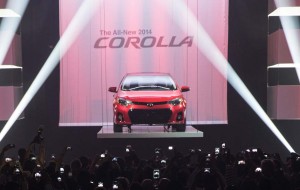
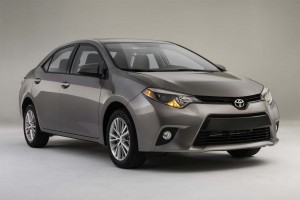
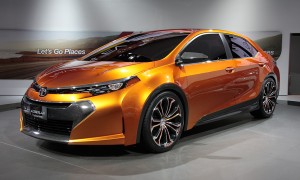
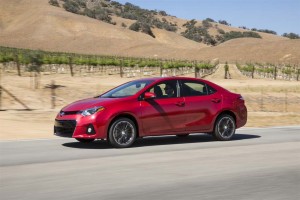
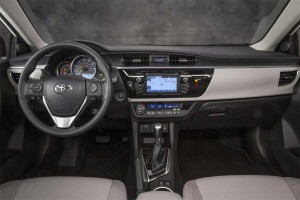
What the Hell is it with the sugar scoop front end styling on all of these new models? Is it monkey see, monkey do or what? It’s not like all of a sudden every designer in the world discovered how to pen a fugly small car front end design using the sugar scoop profile, which is pretty horrible looking IMO.
The “Eco” version is pretty laughable when a clean Diesel will deliver 40+ mpg all day long without the theatrics and it will deliver better city mpg than even most hybrids. Apply the same aero techniques and low resistance tires to a claen Diesel and see what the mpg is, in addition to lower engine maintenance.
I have no doubt though in spite of the blandness of the Toyota and Honda models, loyalists will continue to buy these. I think if the media were to do a little investigation they would discover that what actually keeps Honda and Toyota customers loyal is the dealership experience.
Most Honda and Toyota dealerships actually treat customers with respect and don’t try to exploit them. The service dept. at the dealership is part of the total “ownership experience”. When that experience is positive, especially compared to the typical U.S. or Euro car maker owner experience (in the U.S.), then consumers respond accordingly. Why would a consumer want to endure the abuse and exploitation of a typical U.S. dealership when they can drive a Honda or Toyota and get treated as a valued customer instead?
Darn thing is sooooooooo ugly I first thought that it was so obvious that it was not worth comment!Oon second thought I will say it again
“that thing is soooooooo ugly”
Remember the 77 Datsun F210? that was ugly also!
http://www.thetruthaboutcars.com/2010/01/curbside-classic-the-ugliest-car-ever-1977-datsun-f-10/
There arealways some car designers ans buyer with zero styling judgment. See th Edsel, Aztek, and amany more auto design “mistakes”. It does appear that in recent years the number of “mistakes” has increased significantly.